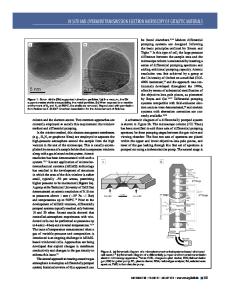Microstructural Characterization of Sintered Ba(Mg 1/3 Ta 2/3 )O 3 Materials by Transmission Electron Microscopy and Con
- PDF / 1,910,014 Bytes
- 6 Pages / 612 x 792 pts (letter) Page_size
- 34 Downloads / 372 Views
Microstructural characterization of sintered Ba(Mg 1 3 Ta 2 3 )O3 materials by transmission electron microscopy and convergent beam electron diffraction J. W. Steeds and I-N. Lin1 Physics Department, University of Bristol, Bristol BS8 1TL, United Kingdom 1 Materials Science Center, National Tsing-Hua University, Taiwan, R.O.C
ABSTRACT Development of high performance dielectric materials is required to facilitate the trend towards miniaturization of microwave communications circuits. A novel two-step sintering process has been found that enhances the value of (Q-factor) (frequency) (QF)product of Ba(Mg 1 3 Ta 2 3 )O3 (BMT). Detailed examination of samples densified in this way gives not only details of the grain size, defect content and state of order of the ordered perovskite grains but also reveals the presence of a number of previously unreported phases. These new phases have been examined by TEM using energy dispersive X-ray analysis to give them approximate chemical composition and convergent beam electron diffraction to determine their crystallography. Large unit cells are found which are evidently related to compounds studied previously in the BaMnO3− x system. The results will be discussed in relation to the enhanced performance of the materials. INTRODUCTION The complex microstructure of sintered BMT samples makes it difficult to identify the key factors that relate to their performance as high dielectric materials [1]. In this study we have undertaken a detailed investigation by transmission electron microscopy (TEM) of a wide range of materials prepared under different conditions [2, 3]. In particular new, previously unreported phases, have been found and have been investigated. Details of their crystallography are given and their possible effect on the performance of the BMT samples is discussed. EXPERIMENTAL RESULTS The samples were prepared for TEM investigation by ion milling. As these materials are highly insulating they charge strongly as a result of exposure to the high energy electron beam. This has several consequences. Insertion, change or removal of the objective aperture generally causes image shift and reorientation. Tilting operations are frequently accompanied by discontinuous jumps of specimen region and orientation. Not infrequently, parts of the specimen break off under the influence of change of electrostatic forces. Moreover the diffraction patterns have very high densities of reflections and the samples suffer radiation damage during investigation. This naturally complicates the process of systematic analysis. However, it was decided not to try to reduce the charging by use of carbon coating as this would have degraded the quality of the electron diffraction data. Since the samples are also quite strongly absorbing it is usual to find an orientation giving strong penetration (anomalous transmission) and this is frequently when a perovskite framework reflection, (100)p (111)p or (110)p, is excited. Under these conditions the defects of ordering (twins and translation domains) appear un
Data Loading...











